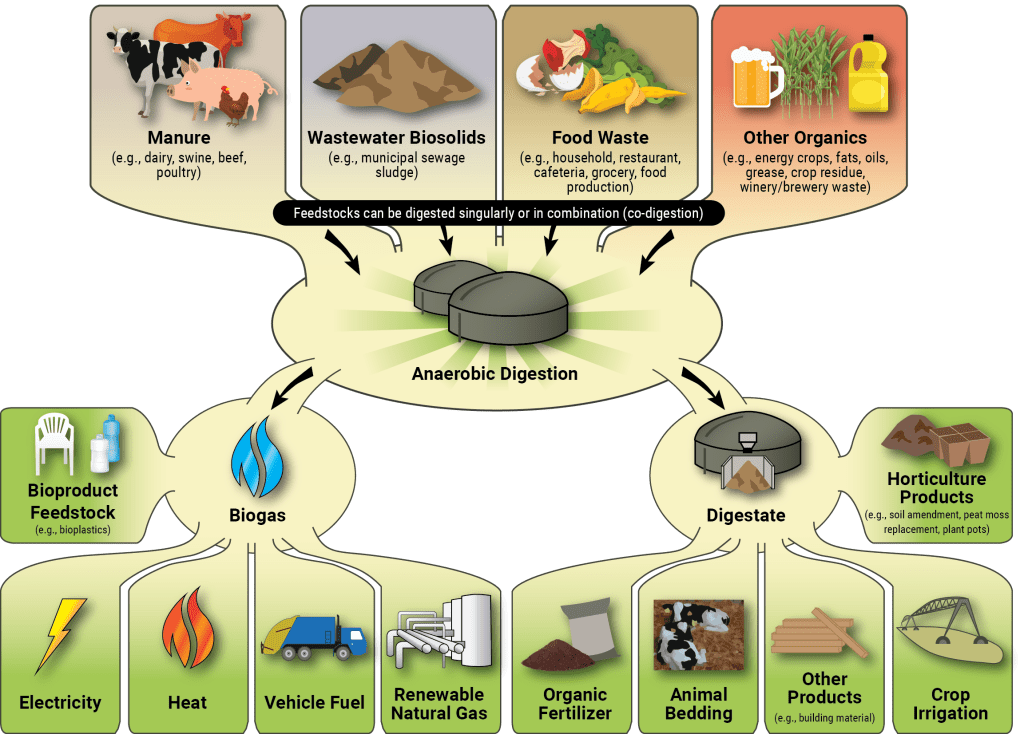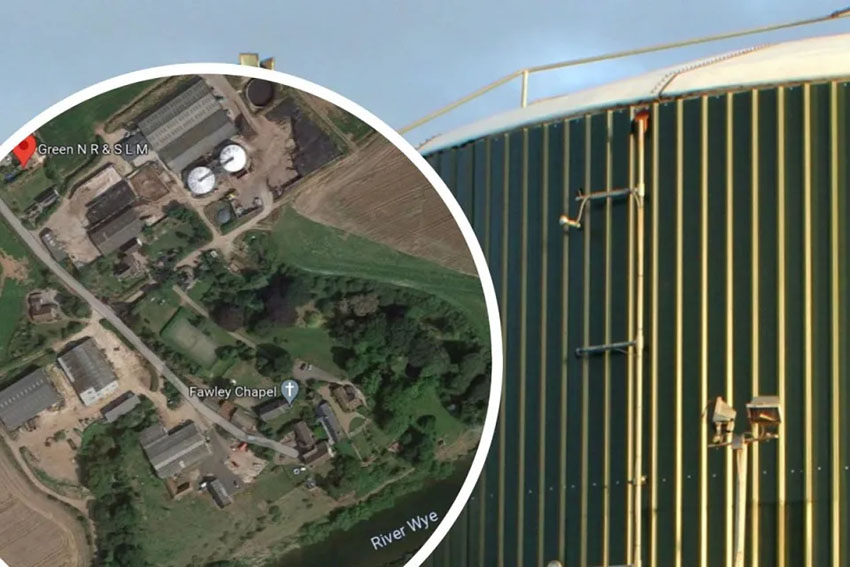In an era where sustainable energy sources are vital for economic and environmental well-being, biogas emerges as a compelling contender. Biogas offers significant economic benefits, from reducing energy costs and generating revenue to job creation and waste management. Biogas stands as a carbon-neutral, sustainable energy resource. It can serve as a direct replacement for natural gas in industrial, commercial, and residential applications. We must explore the multifaceted advantages of harnessing biogas for a more prosperous, sustainable future.
What is Biogas?
Biogas is a mixture of methane, CO2, and small quantities of other gases produced by anaerobic digestion of organic matter such as food waste, agricultural waste, or sewage in an oxygen-free environment. The precise composition of biogas depends on the type of feedstock and the production pathway. IEA (2020) states that anaerobic digestion (AD) is the bacterial breakdown of organic matter without oxygen. It occurs in sealed reactors of various shapes and sizes, which in turn produce biogas as end-products.
The UNFCCC has coined biogas as a “multi-win industry“. Anaerobic digestion, in particular, stands out as a readily deployable technology that achieves decarbonisation. Crucially, since it is a technology in widespread use today, it has the capacity to realise its full potential. Notably, biogas can reduce global greenhouse gas (GHG) emissions by a minimum of 10% by 2030. In addition, the industry has the potential to create 10-15 million new green jobs, decarbonise challenging sectors such as heat, transport, and agriculture, and enhance energy and food security for every nation.
Biogas and biomethane share their renewable origins in organic waste. The production of biogas may lead to methane emissions. It’s essential to highlight the key distinction between biogas and biomethane. Biogas typically comprises 50 to 70% methane, while biomethane undergoes a purification process that removes carbon dioxide, hydrogen sulphide, and water from the initial biogas composition.

Source: UNEP.
How Is Biogas Produced?
There are three main technologies used to produce biogas:
- Biodigesters: Anaerobic digesters are sealed structures like containers or tanks where organic matter, mixed with water, undergoes decomposition through naturally present microorganisms. Typically, the anaerobic digester removes contaminants and excess moisture before utilising the biogas.
- Landfill System: At landfill sites, the anaerobic breakdown of municipal solid waste (MSW) results in the generation of biogas. The landfill system collects biogas using pipes and extraction wells, aided by compressors that promote its flow to a centralised collection point.
- Wastewater treatment facilities: These facilities have the potential to be outfitted for the reclamation of organic substances, solids, and essential nutrients, like nitrogen and phosphorus, from sewage sludge. After undergoing additional treatment, this sewage can serve as a resource for generating biogas within an anaerobic digester.

Source: Yahoo!Sports.
Why is it essential that we focus on The Economic Benefits Of Biogas?
The economic benefits of biogas depend on feedstock, energy costs, incentives, and regulations. Properly managed, biogas contributes to both economic growth and environmental sustainability, offering various economic benefits.
The Benefits of Biogas: Reducing energy costs
One of the primary benefits of biogas technology is that it is affordable and easy to implement on a small scale, particularly for household use with minimal investment. As such, families can reuse kitchen waste and animal manure to eventually become self-sufficient. The biogas they produce can directly fuel cooking and electricity. Furthermore, farms can convert livestock waste into energy, with even a single cow’s waste powering a lightbulb for a day.
On a worldwide scale, the expenses associated with biogas production currently span a broad spectrum, ranging from USD 2/MBtu to USD 20/MBtu (Million British Thermal Units). Regional disparities are also prominent. For example, the average cost of biogas is around USD 16/MBtu in Europe, while it’s USD 9/MBtu in Southeast Asia. Moreover, approximately 70 to 95% of the overall biogas expenses are associated with the installation of biodigesters. However, biogas can create revenue through surplus sales to the grid or electricity generation, offering an additional source of income for biogas producers.
Biogas Creates Jobs
The biogas industry is vital in bolstering local economies and regional communities because it generates employment opportunities. In 2021, the biofuels sector provided 2.4 million jobs, with the majority of the workforce involved in feedstock operations. The potential, therefore, for biogas to create more jobs extends to a variety of areas, encompassing the construction and operation of biogas plants, as well as the collection and processing of organic waste.
Notably, Europe, China, and the United States jointly account for 90% of global biogas production. In Europe, for instance, both direct and indirect employment in the biogas industry has exhibited consistent growth over the years within the European Union. For example, in 2021, this sector employed 47,100 individuals, directly and indirectly.
Agricultural Benefits
Agricultural biogas production transforms agricultural residues into green energy, offering farmers additional income and cost savings on fertilisers. It also enables the replacement of traditional inputs with biogas slurry and biogas for cooking and heating, leading to improved overall quality of life. This enhances stables, and farmyard manure can increase livestock output as well as crop yields.
Waste Management and Carbon Credits Benefits
Globally, humans generate more than 105 billion tonnes of organic waste. Biogas systems provide us with cost-effective waste management by treating organic waste from various sources. Biogas technology aids in resolving public waste disposal and wastewater treatment challenges. Additionally, it helps reduce greenhouse gas emissions by capturing methane, offering financial benefits through emissions reduction credits or carbon trading.
How rotting vegetables make electricity.
Source: YouTube.
Moving Forward
Biogas and biomethane, while initially limited, experience rapid growth within the bioenergy sector. According to the IEA sustainable development scenario, their combined market share is estimated to increase to 20% by 2040. Furthermore, this growth indicates a significant shift towards sustainable energy solutions. However, currently, biogas and biomethane projects represent only a small fraction of total global spending on gas.
Promoting biogas involves several key aspects. For instance, ensuring a sustainable supply of feedstocks through waste management, incentivising consumption by creating jobs, offering subsidies, and supporting the supply side with standards, technical innovation, and international assistance are critical components of this effort.

Source: IEA (2020).
achieving the United Nations Sustainable Development Goals (SDGs) and how they link to The Economic Benefits Of Biogas
Biogas is a versatile resource that aligns with several Sustainable Development Goals and contributes to a sustainable future.
- SDG2: By enabling rural communities to convert organic waste into renewable fertiliser and supporting agricultural productivity and localised food security.
- SDG7: Biogas is a flexible and renewable fuel source that can be used for heating, cooking, and electricity generation, promoting sustainable and clean energy access.
- SDG8: The biogas industry fosters innovation, creating opportunities for job growth and economic development as it optimises organic waste utilisation and requires various skills for operating larger biogas plants.
- SDG12: Biogas plays a role in responsible consumption and production by effectively managing and recycling organic waste.
- SDG13: Biogas aids in decarbonisation efforts and greenhouse gas reduction, reducing reliance on fossil fuels and benefiting the climate.
A Thrivable Framework
The THRIVE Framework examines issues and evaluates potential solutions that can support economic growth. The THRIVE platform is scale-linked, values-based, context-based, and science-based, informed by the natural sciences. At THRIVE Project we provide research, education, and advocacy to create a sustainable future, going beyond, teaching humanity how to thrive in harmony with all living matter.
THRIVE stands for The Holistic Regenerative Innovative Value Entity. That is our name and that is our game. We aim to walk the talk and we invite you to join us. We have nothing to sell, but we’d like to share with you our way of thinking so that our planet and species has the chance to go beyond surviving and actually thrive.
If your interested in joining us, there are a variety of avenues you can take. One way of keeping us with us is via social media platforms, such as LinkedIn, X, Instagram, and Facebook. However, you could subscribe to our YouTube channel, listen to our podcasts, sign up to our newsletter, stay up to date with our blogs, attend our free webinars, or even join us as a volunteer to make an even bigger difference in this world.






















